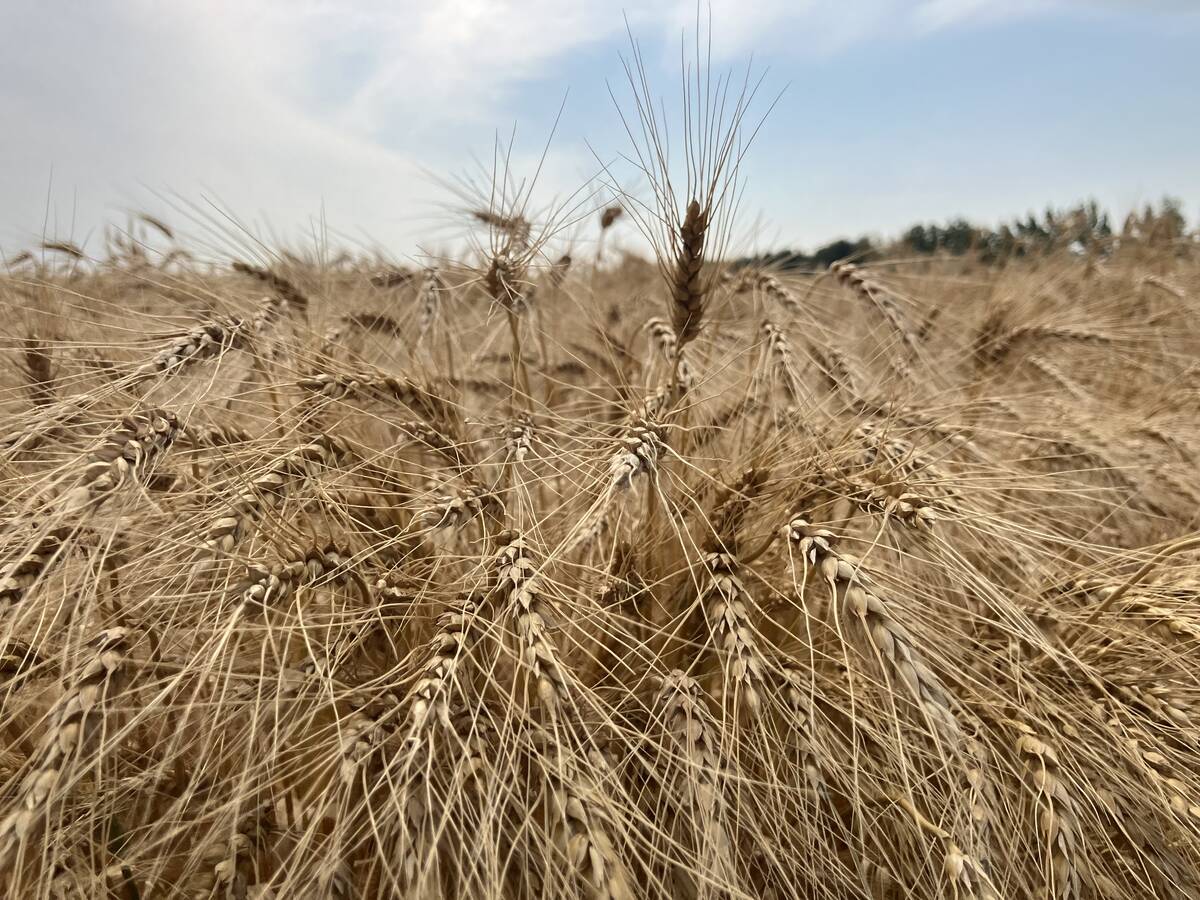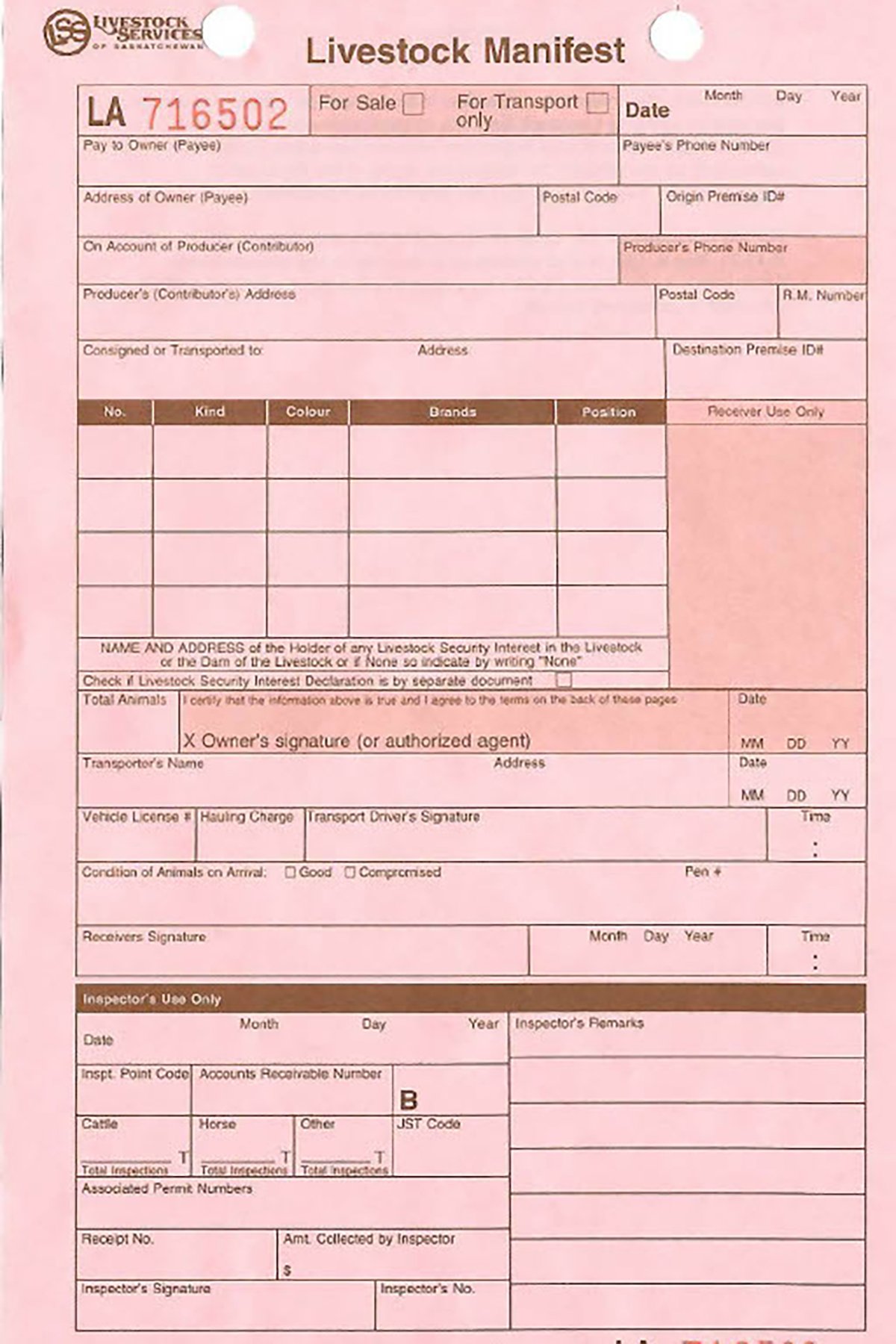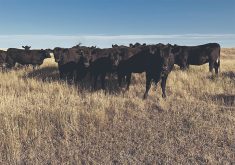It’s time for Saskatchewan livestock producers to start memorizing their premises identification number.
As of Jan. 1, 2025, producers are required to fill out their origin and destination PIDs on livestock manifests.
“The premise ID, origin and destination, have been on the manifest for several years now,” said Jason Pollock, chief executive officer of Livestock Services of Saskatchewan (LSS).
Read Also

Prairie spring wheat looks like a bumper crop
Canada will likely set a new record for spring wheat yields this year, topping the previous mark of 54.1 bushels/acre – set in 2020
“But as an organization, we’ve never really taken any sort of interest in asking whether or not that’s on there, or requiring it to be on there to be a properly filled-in manifest.”
That’s now changed.
In accordance with new legislation under the amalgamated Animal Production Act, PID must be recorded on the manifest when handed to the inspector. The cattle’s destination, such as an auction mart or feedlot, is also required to have their PID clearly posted and available for a producer to find upon arrival.
Pollock raised awareness of this regulatory change and others at the Saskatchewan Stock Growers Association’s semi-annual meeting Feb. 7.
He said this change and others, such as a manifest security declaration, brand types, purebred inspection and licensing, were in the works for nearly five years at Saskatchewan Agriculture. Some of the new regulations came into effect in July, but others, such as the security declaration and PID, are more recent.
The changes are intended to increase efficiency, eliminate future confusion and ultimately make things easier for inspectors and producers. In the example of the PID requirement, it is a “tightening up” of security, allowing for better tracing ability in the case of an animal health emergency.
The regulatory change also brings about a new section on the manifests — a security declaration. It’s below the animal table and reads, “name and address of the holder of any livestock security interest in the livestock or the dam of the livestock or if none so indicate by writing ‘none.’ ”
The declaration is in addition to the consigner, contributor and producer information, all of which must be filled out by the producer.
The change is to provide the marketer and buyer with protection in case there are issues with distributing funds from the sale, such as disputes of ownership or events of fraudulent activity.
It also aligns Saskatchewan’s manifest with that of Alberta, which has a similar declaration to provide protection.
“If there’s no lien or no financial encumbrance on those animals, you’re writing ‘none,’ ” Pollock said.
“And then, if you supply a clearance, there’s a check box for you to say that the clearance is provided in documentation that is attached to the manifest.”

When discussing the technicalities of “financial encumbrance,” it’s understood that a majority of producers have a general security agreement (GSA) for their operation. This declaration is intended for producers to state any applicable livestock loans or livestock purchasing credit such as those from the Saskatchewan Livestock Finance Co-operative, Canadian Cattle Buyers Credit and other financial institutions.
“What this is designed to do is have the producer say, ‘oh right, I did get a loan for these (animals) from XYZ, and I need to provide clearance.’ ”
It’s also intended to eliminate unnecessary withholds and redirections that LSS puts in place when financial security clearances aren’t provided by the seller. It increases the efficiency of the sale process for those with loans or credit.
Because the declaration is a new section and a new requirement, it means new manifests.
However, producers won’t be penalized or fined for not having the updated manifests right away.
“There’s going to be a period of time where there’s a lot of (old) manifests in circulation — glove boxes of trucks, dashes, everywhere,” said Pollock.
“You know they are going to still come in over time, and we’ll honour those.”
Producers aren’t expect to rush out to get new ones immediately but are encouraged to obtain the updated version at their earliest opportunity.
There will be a similar, “graduated” approach to the new PID requirement as well.
“We always encourage, with all of our inspectors, to use a soft awareness approach and not really a hard-nosed approach to all of these things,” he said of the changes.
“If it’s not there, we’ll simply point out to the producer that it is now a requirement.”
The goal is first awareness of the changes and education on their importance. In some cases, producers may not have a PID yet, despite their introduction in 2013. Producers who don’t have one or are unaware of what theirs is should contact Saskatchewan Agriculture.
However, the changes are now being enforced.
An inspector’s first move is to inspect the manifest, and if it’s not filled out properly, they’re directed to return it to the producer with instructions on how to complete it. Pollock is aware that a properly filled out manifest may vary from how an individual thinks it should be filled out.
He hopes that in short time, everybody will be in compliance with these changes.
“We’re not going to be walking around with big sticks, trying to catch people in the act of disobeying the manifest rules. We’re looking at this as, we’re producers too and regulations are a part of it (being a producer), and we all need to be doing our part.
“Our part (as inspectors) is just to help people know what their responsibilities are and then gently remind them and then let the chips fall where they may.”
Digital manifests
The new Animal Production Act also allows for digital platforms to be an official record, which is a mechanism some producers have been waiting for.
When the LSS board was created 10 years ago, a new database was also created. And with it was an idea of eventually incorporating an electronic manifest and permit. After “numerous starts and stops,” MyLivestock.ca was officially rolled out in the spring of 2024.
Phase one of MyLivestock, which is complete, was to comply with federal transport regulations established in February 2022. Phase two is to integrate the provincial legislation into the system, and that is currently in progress.
The program includes CCIA reporting, PigTRACE reporting, manifests and transport records. With new regulatory changes, producers can also renew their brands. LSS hopes that it will be able to integrate its services to be able to perform inspections with a digital manifest.
The overall concept of the program is to use information from the manifest across the various layers of regulation on behalf of the producer if they so choose.
“The producer still owns the ability to direct where their infomation goes, and how they use their information, because ultimately, it is their information,” said Pollock.
Producers are required by law to provide certain information, MyLivestock offers an option on how they do it. And it is an option — Pollock made clear that no one will be forced to use the service or completely get rid of paper.
“We do not see a time in the future where paper will be abandoned… It’s hard to move away from something that’s not broke. But the reality of paperwork, especially when you talk about a TB investigation, or heaven forbid, a foot-and-mouth event, the access to information in a paper based system compared to a digital based system are completely different.”
While response to a disease outbreak isn’t LSS’s or any individual producer’s responsibility, LSS does assist and wants to have information available and prepared. Data such as transport and PIDs are essential for the Canadian Food Inspection Agency to do its job well.
LSS is following the lead of Alberta, which is currently operating an electronic manifest pilot program. It’s used by the province’s large feedlots. LSS is doing the same thing to work out any bugs before moving the digital manifest aspect forward.
“The last place that we’ll put it is the markets because that’s the most complex area and there’s so many moving parts,” Pollock said.
If producers have questions regarding how changes may affect them, or are looking for specific information, they can reach out to their local inspector or local district manager or call the LSS head office at 306-546-5086. Additional contact information can be found at lssc.ca.


















